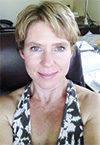Twenty years ago, I didn’t know the first thing about dairies, much less what dehorning entailed. Then one rainy December day, my roommate got word that his dairy farmer brother was coming to pay a visit.
I went to work at my job waiting tables in downtown Olympia, Washington, and didn’t think much more of it until this Wrangler-clad, out-of-place guy sauntered in with my roommates to grab a bite to eat. He had beautiful hazel eyes, a booming voice and a wide flashy grin. He topped the Wranglers off with a plaid shirt and a ball cap that said, “Agitators and Separators.”
Naturally, after having lived in Olympia, a mecca for such types, I assumed he was a protestor of something, so I asked what he was protesting and agitating against. He laughed and said, “Nothing. Manure agitators and separators.” Oh. That was the beginning of a long and hilarious evening in which my friends and I learned all about what it takes to be a dairy farmer.
We learned dairy vocabulary and got detailed descriptions of common dairy practices, including an eye-popping discussion on artificial insemination. I was in awe of this man’s vast array of knowledge about all things farming and his determination to succeed at it.
Fast forward a marriage, three kids and almost 20 years, and I am still finding out new things. I’m not the naïve town girl I once was. My expertise on the dairy has become raising calves – with the exception of dehorning. Although I knew dehorning was a necessary part of animal handling, I didn’t enjoy seeing the calves suffer. My husband traditionally did this when the calves were weaned and more difficult for me to handle, so this was his task and I mistakenly assumed his method was the only way dehorning could be done.
That assumption changed when I read an article about a better, less painful way to dehorn. The article suggested that rather than dehorning calves at two to three months, it is much easier to disbud the calves at a much younger age with a hot iron and the use of anesthetic for pain relief. I learned when you disbud a calf, you are removing the horn cells before they are firmly attached to the skull of the calf, making the process much less invasive and traumatic. I ordered the calf disbudder right away, and at the next vet check, I asked our veterinarian if he could teach me how to give the anesthetic effectively and perform this new method.
After a short training session, I was educated and ready to go on my own. This one simple change in management on our farm has been positive in a number of ways. Most notably, our calves suffer minimally during and after the disbudding process. Seconds after the procedure is done, their ears are perked, their heads are up and they are ready to go on about their day normally.
In addition, disbudding calves at less than 3 weeks old with this method means that the job is less physically demanding, so it has been an easy job for me to take off of my husband’s long list of chores. I feel good knowing that I have truly made our farm a place where I can say that animals at all ages and stages are living a comfortable, clean and well-fed life with a conscious effort to minimize suffering.
Humans are creatures of habit. Making changes to commonly accepted practices can be a challenge. This was made apparent to me in a driver’s education parent meeting I attended for my daughter a month ago. Her teacher spent a good deal of time teaching us that some of the driving techniques we learned 25 years ago, such as where we place our hands on the steering wheel and how we position our rearview mirrors, are now not considered the safest or best driving practices.
It’s a strange and uncomfortable feeling to realize that some of our previously accepted ideas or actions aren’t necessarily the best ideas or actions – that better ways have now been developed. Mostly it can make you feel really old and not very cool compared to your hip, up-to-date teenager.
Socrates said, “The secret of change is to focus all of your energy not on fighting the old, but on building the new.”
What a good lesson to learn. Nothing in our world is static. Our dairies and the practices within them change and evolve, and to be successful, we must be flexible enough to change and evolve too – for the welfare of our animals and ourselves. PD
Rebecca Lampman lives and works with her husband and three children on their 250-cow dairy farm in Bruneau, Idaho. She enjoys long walks, her kitty cat, Ollie, and change.





